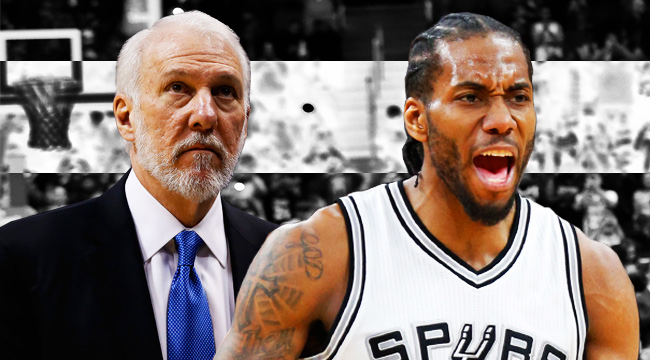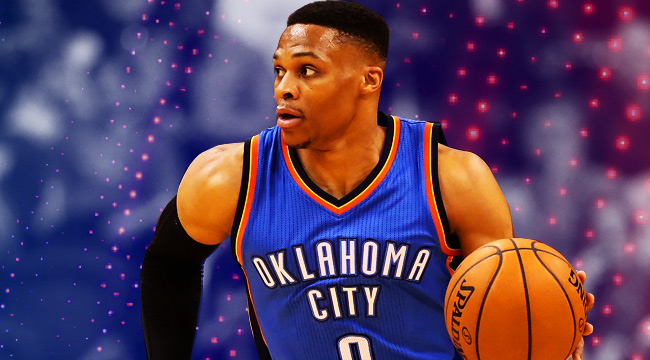
The best shooters in the NBA have a gravity that can single-handedly change how opponents defend their team. They don’t even have to touch the ball to warp the defense and create openings for their teammates. Shooters like Klay Thompson, J.J. Redick, and Kyle Korver can receive a down screen out to the three-point line and all five defenders are fully trained on those guys. Spot-up bombers like Ryan Anderson, Eric Gordon, and Kevin Durant don’t even have to move to command the defense’s attention. Elite off-the-dribble long-range scorers like Stephen Curry, Damian Lillard, and Kyrie Irving put panic into the hearts of defenders due to their ability to create an open look from deep all on their own.
But nothing has more gravity than the ball itself.
The San Antonio Spurs understand the gravity of the ball better than any team in the league. Nobody swings the ball from side to side to pressure the defense better than San Antonio. The Spurs finished fourth in passes per possession last season and Brett Brown and Quin Snyder, who are direct descendants of Gregg Popovich’s coaching tree, man the sidelines for two of the three teams who finished above them.
The Spurs’ ball and man movement drives their entire offensive philosophy. While San Antonio finished with the fourth-slowest pace in the league in 2016-17, they’re certainly not standing around pounding the ball through the hardwood. They always sprint up the floor into their sets, then take their time from there, moving the ball and their players to find the best shot. Despite their slow overall pace, the Spurs ran the second-most total miles on offense in the league and no team had as much movement on a per-possession basis than San Antonio.
All that ball and man movement generates open shots consistently, despite changes in personnel over the years. They’ve been among the top six teams in the league in three of the past four years in wide-open shots generated (defined as a shot with the closest defender being further than 6 feet away) and in the top five in wide-open jumpers.
San Antonio runs specific sets to take advantage of the gravity of the ball to get open looks for Kawhi Leonard and Danny Green, their two best shooters. Ram Fan puts Leonard’s defender in an impossible situation, asking him to either stick with Leonard and give up a lane to the basket or leave Leonard to help out his teammates and cede an open shot to one of the best shooters in the league.
The Spurs will often have Leonard play the 2 in the above diagram, where he will set the ram screen for one of the Spurs big men, then cut through to the opposite corner. After Leonard sets that screen, his defender is briefly responsible for the 1-4 pick-and-roll that follows, as the 4’s defender has been taken out of the play intermittently by the Leonard screen. The ball’s gravity is what causes this indecision for Leonard’s defender—he has to address the more immediate threat (the pick-and-roll), but doing so allows Leonard to get free in the opposite corner.
As Leonard cuts through to the other side of the floor, three defenders surround the ball leaving just two to guard Leonard, Green, and the other big man on the weak side. As the point guard dribbles to the middle of the floor, he has a plethora of options—the best defenses will rotate to take away Leonard, but that leaves either Green open on the wing or the cutting big man open along the weak side baseline for an easy dunk.
Another essential set the Spurs have in their arsenal is their famous Hammer set, in which a guard drives to the baseline, moves the defense toward him, then throws the ball across to the opposite corner for a wide-open three. There are many different hammer sets, but the central action remains the same:
In this version, the eventual shooter (2) is involved in the dummy action at the beginning of the play, setting a screen for the 3 to come out to the right wing, where he can either receive a side ball-screen from the 4 or just drive baseline immediately, looking for the 2 cutting to the corner behind the hammer screen from the 5. The ball draws all ten defensive eyeballs, which is exactly what the Spurs are anticipating. The defense will rotate over or collapse down on the 3’s drive, but he’s not trying to get to the rim—he just needs to open up the angle to throw the ball along the baseline to the opposite corner.
In an effort to remain elite on the defensive end of the floor, the Spurs have eschewed the modern philosophy of employing a versatile power forward in order to play with two traditional big men. The biggest effect that this decision has on the offense is that San Antonio rarely has more than two or three high-level outside shooters on the floor at any given time and instead rely on more traditional means to find their points.
San Antonio runs a lot of their offense through the post and the elbow, relying on Leonard and their big men to be equal parts scorer and passer from those positions. Since the end of the Tim Duncan era, they’ve specifically signed big men who are able to shoot from those spots on the floor. LaMarcus Aldridge, David Lee, and Pau Gasol all fit this mold, which changes a lot of what the Spurs can do offensively.
Putting a good shooter and passer on the elbow is a huge advantage for San Antonio, because the guy defending the ball has to be on his guy closely, otherwise the mid-range jumper is wide open. Forcing the defender up on the ball opens up all the backdoor cuts and split cuts the Spurs like to run through their big men. Even something as simple as Center X is tremendously more effective when they employ a jump-shooting big man to run the action:
As the point guard enters the ball to the 5 near the elbow, both guards execute a split cut off the 5, perhaps opening up an opportunity for a quick basket if the defense isn’t aware of the cut to the rim. If the 5 is a non-shooter, then his defender is hanging back in the paint and cuts off that chance altogether. Similarly, when the DHO occurs with the 3, the 5’s defender is up on his man, making it much more difficult to defend the handoff, often requiring a third defender to rotate over, leaving an open man for the 3 to find from the middle of the floor.
Watch how Marcin Gortat being forced to guard Gasol at the free-throw line opens up the hand-off and layup for Tony Parker:
It’s no accident that the Spurs are continuously at the top of the league in pass and assist percentage from the elbow. They explicitly target big men who can look for cutters and shooters from these positions. The same goes for the post, where they haven’t been lower than fourth in the league in either pass percentage or assist percentage over the past four seasons. Usage of the post game has fallen off in recent years across the league, but the Spurs still use it to their full advantage. The fact that the Spurs big men can consistently find the open man drastically changes how defenses play them in the post.
The post game hasn’t waned because guys aren’t good at putting the ball in the basket from there—it’s because the rules allow defenses to double the post far easier than they could in the past, making it much harder for these opportunities to exist. A good passer out of the post is essential in today’s NBA, because it either slows down those double teams, allowing more room for that guy to operate in the post, or he’s able to find the open man when the double team does come to him.
San Antonio isn’t the only team in the league doing this. The basis of Memphis Grizzlies is to run a lot of their offense through Marc Gasol, the Denver Nuggets do the same through Nikola Jokic, and the New Orleans Pelicans have two such big men in Anthony Davis and DeMarcus Cousins.
The natural progression for the big man of the future is to not only be able to shoot and pass from the elbows, but also put the ball on the floor and get to the rim. This is where the Pelicans are of particular interest, as they have brought together a pair of quality ball-handlers at the big man positions in Davis and Cousins, who finished first and sixth overall among qualified big men in points per possession on drives, respectively, last season.
Of course, Cousins played most of the 2016-17 season with the Sacramento Kings, but their placement on this list shows just how effective both Davis and Cousins are individually with the ball in their hands. Both also appear in the top five of elbow touches per game last season, where many of their drives to the rim started.
The ability of Davis and Cousins to drive to the rim puts those same sets the Spurs run on an entirely different level. Where the Spurs’ big men are mostly stationary, either shooting, passing, or executing a handoff from the elbow, Davis and Cousins can move toward a dribble handoff, then tuck the ball and go to the basket, making it almost impossible for the defense to choose between the guard flying around the handoff action and the big man who may fake the handoff and take the ball himself.
Even more lethal is the handoff between Davis and Cousins, which the Pelicans experimented with at times last year, usually to strong results. Placing two big men in this action who can create for themselves is an absolute headache for defenders, who aren’t used to fighting through the screen that comes with the handoff.
Using big men in roles traditionally reserved for ball-handlers dramatically impacts the gravity of those players and the actions they run. Because the defenders involved are playing roles outside of their normal comfort zone, their teammates are even quicker to help, opening up spot-up opportunities as well as backdoor cuts for easy layups. Davis and Cousins don’t have to swap isolations or post-ups every other possession down the floor—using them together brings the best out of both of them.

Guards who can effectively post up are the other side of this coin. Point guards like Shaun Livingston, Marcus Smart, and Russell Westbrook are increasingly more valuable in the post as teams defend them with smaller players who aren’t used to the physical demands that come with defending down low. These guys can score for themselves in the post, using their superior length, physicality, and athleticism to create easy shots, but the more important impact of their post-ups is when the defense collapses on them and they can kick the ball out to the perimeter for an open three-point jumper.
Superstar offensive players have more gravity than their peers and coaches can scheme to increase the gravity of their best shooters, but ultimately, nothing has more gravity than the ball itself, and the Spurs have been using that fact against their opponents for years, moving the ball from one side of the floor to the other in order to create openings, so much so that some plays are even designed with the inherent knowledge that their opponent will track the ball so intently that they forget about San Antonio’s best player on the weak side.
The Spurs and others also use the gravity of the ball to take advantage of uncomfortable and unconventional situations, such as an exceptional passing or ball-handing big man or a post-up threat at point guard, to bend the defense’s attention toward the ball before kicking it to an open cutter or three-point shooter.
San Antonio focuses their efforts on signing players who fit their pass-heavy style to keep as much pressure on opposing defenses as possible, without giving up anything of their own on the defensive end, while New Orleans has paired perhaps the two best ball-handling big men in the game to create havoc on defenses with mismatched skillsets.
The gravity of the ball will always reign supreme and the offenses that understand this best will thrive regardless of changes in personnel.






